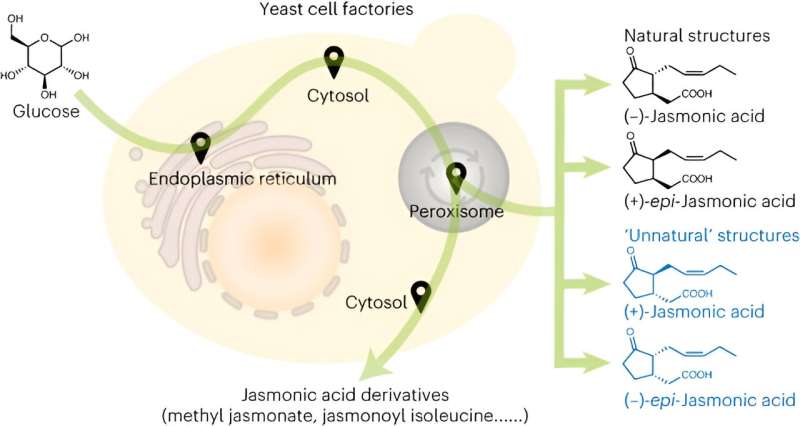This article has been reviewed according to Science X's editorial process and policies. Editors have highlighted the following attributes while ensuring the content's credibility:
fact-checked
trusted source
proofread
Yeast engineering leads to new frontiers in jasmonate biosynthesis

A research team led by Prof. Luo Xiaozhou from the Shenzhen Institute of Advanced Technology (SIAT) of the Chinese Academy of Sciences (CAS) and Prof. Jay D. Keasling from the University of California, Berkeley, has developed an engineered yeast to produce vital plant hormones known as jasmonates, including jasmonic acid and its derivatives, methyl jasmonate and jasmonoyl isoleucine.
The study was published in Nature Synthesis on Nov. 13.
Jasmonic acid and its derivatives are collectively called jasmonates. They play a key role in plant growth, stress responses, and defense mechanisms and have potential uses in medicinal applications. However, extracting these hormones from plants is like finding a needle in a haystack; it produces extremely low yield and is environmentally taxing.
Saccharomyces cerevisiae has been widely used for industrial production of biochemicals. It harbors various organelles that are essential for reconstitution of plant pathways with multiple enzymes and different native locations.
Jasmonates biosynthesis is a complex, multienzyme-catalyzed process that exhibits extensive compartmentalization, with enzymes active across the chloroplast, peroxisome and cytosol. The chloroplast is the compartment for production of the precursors α-LeA and oxo-phytodienoic acid (OPDA). As yeast does not have a chloroplast, reconstitution of the jasmonates pathway presents a challenge as a result of the incompatibilities of enzymes adapted for unusual contexts.
To address these challenges, the researchers used enzymes located in the endoplasmic reticulum and cytosol to generate the intermediates α-LeA and OPDA. Genome editing was performed using the parent strain Lab001, and the final engineered strain, which integrated 15 heterologous genes from diverse plants and fungi and had three of its native genes deleted, produced jasmonic acid at titres of 9.6 mg·L-1 in flask cultures. Further strain engineering also enabled the production of 3.1 mg·L-1 methyl jasmonate and 7.0 mg·L-1 jasmonoyl isoleucine, respectively.
"The proposed technique offers a more efficient, cost-effective, and environmentally friendly method than current chemical synthesis or extraction processes," said Prof. Luo.
The team is exploring ways to scale up production, aiming to bring this technology to commercial viability.
"The chemical synthesis of jasmonates is typically low yielding and can be laborious, and their extraction can be costly or environmentally hazardous. Now a de novo biosynthesis of jasmonic acid and its derivatives, methyl jasmonate and jasmonoyl isoleucine is reported, using an engineered baker's yeast," said Thomas West, editor of the journal.
More information: Hongting Tang et al, Engineering yeast for the de novo synthesis of jasmonates, Nature Synthesis (2023). DOI: 10.1038/s44160-023-00429-w
Provided by Chinese Academy of Sciences





















